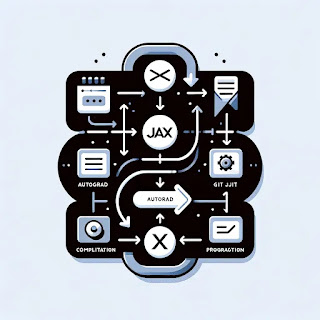Introduction to Google JAX
Google JAX is an open-source numerical computing library developed by researchers at Google. It's designed to bring the power and flexibility of Python to the high-performance computing arena, enabling researchers and developers to write high-speed, efficient code for advanced machine learning and scientific computing tasks. JAX stands for "Just After Execution," reflecting its core ability to automatically differentiate native Python and NumPy functions.
Why Google JAX Stands Out
- Autograd for Automatic Differentiation: JAX extends Autograd to efficiently compute gradients for complex functions. Unlike other frameworks that require special tensor types or graph-building interfaces for differentiation, JAX allows you to write your mathematical code in plain Python and NumPy, and then it takes care of the rest.
- XLA for Acceleration: JAX uses XLA (Accelerated Linear Algebra) to compile and run your NumPy programs on GPUs and TPUs. This feature means that the same JAX code can be run on different hardware accelerators, making your code both flexible and fast.
- Just-In-Time Compilation with
jit: JAX'sjitfunction compiles your Python functions into fused operations that run efficiently on hardware accelerators. It's particularly beneficial for functions with loops or control statements that would otherwise be slow in Python. - Functional Programming Paradigm: JAX encourages a functional style of programming. This design choice aligns well with mathematical code and makes it easier to reason about program behavior, especially when it comes to parallelism and transformations like
jit,vmap, andpmap.
Comparison with Other Frameworks
- TensorFlow and PyTorch: While TensorFlow and PyTorch are more popular for deep learning applications, JAX offers a more straightforward approach to automatic differentiation and GPU/TPU acceleration. Its functional programming model is more suited for researchers who want fine control over their mathematical computations.
- NumPy: JAX can be seen as an extension of NumPy, providing GPU/TPU support and automatic differentiation while maintaining API compatibility. This compatibility means that you can replace
import numpy as npwithimport jax.numpy as npand get the benefits of acceleration and autograd without changing your NumPy code. - Speed: Benchmarks show that JAX's just-in-time compilation to GPU/TPU can lead to significant speedups, especially for complex calculations that benefit from parallelization. Its performance is comparable to or even exceeds that of highly optimized TensorFlow or PyTorch code, particularly for smaller batch sizes where JAX's fine-grained control over computation shines.
In summary, Google JAX offers a unique blend of simplicity, power, and flexibility, making it an excellent tool for scientific computing, machine learning research, and anywhere you need high-performance numerical computation. Whether you're a researcher, a data scientist, or a developer, JAX provides the tools to make your numerical computations faster, easier, and more expressive.
Tags:
- #GoogleJAX
- #NumericalComputing
- #MachineLearning
- #ScientificComputing
- #PythonProgramming
- #GPUPerformance
- #TPUAcceleration
- #Autograd
- #JAXLibrary
- #DeepLearning

Comments
Post a Comment